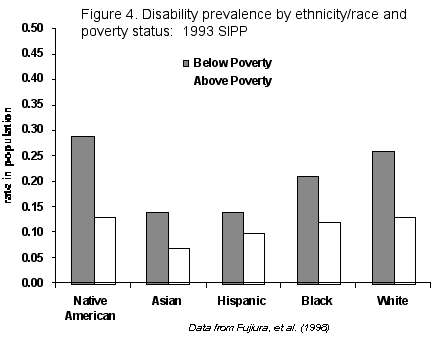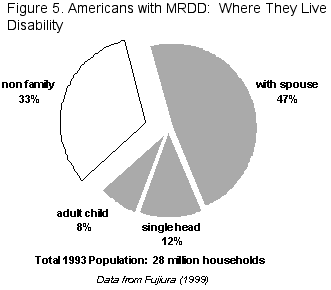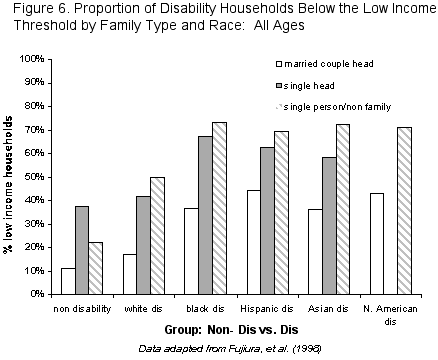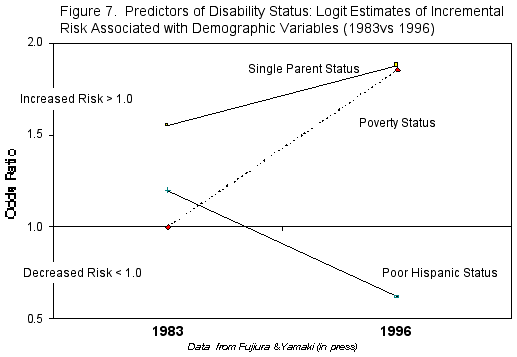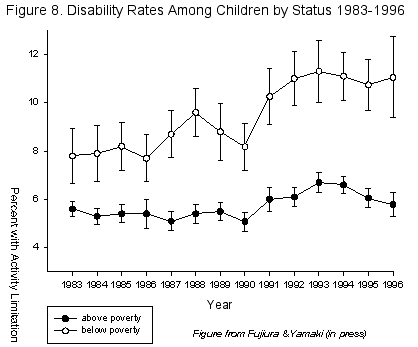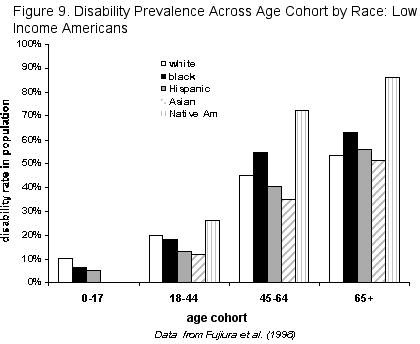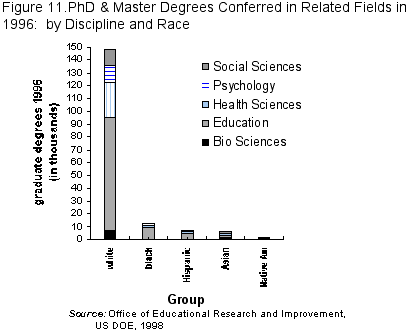| Document Source: http://www.mswitzer.org/index.html
The Implications of Emerging Demographics:
Glenn T. Fujiura, Ph.D.
Preparation of this article was supported in part by Grant No. H185A200211 from the National Institute on Disability and Rehabilitation Research Key Terms: demography, disability, families, minorities, poverty, prevalence, race Address Correspondence to:
Introduction In the following pages I paint a demographic portrait of Americans with a disability. A very broad brush will be used. Though many different demographic features, methodological concerns, and disability issues are explored, each coalesces around a core question -- what is the significance of race and ethnicity to those of us in the disability community? I say "address" the question rather than "answer" for the very practical reason that I have no answers. This was the question of President Clinton's Initiative on Race (Executive Order 13050). I doubt anyone believed the response would be anything but "yes." However, the ways in which race affects us remain very much a matter of debate. The lesson of the Presidential initiative was that while we all understand in very general terms the profound influence of race, we truly do not understand its "genesis and consequences" (Advisory Board to the President's Initiative on Race, 1998, p. 3). Until we do understand its consequences and look deeply into its history and dynamics, problems remain ill-defined and solutions elusive. As always, the devil is in the details. In the recent flurry of public debate over affirmative action, and in all the rhetoric generated by the Presidential race initiative, I am a somewhat surprised that we have not directly addressed this question of race in greater depth within the disability community. If we were to poll people in the field, I am certain the consensus answer -- implicit in words if not deeds would be a resounding "yes" Race is a standard item in our list of disability concerns. We have our centers, and initiatives, and demonstration projects, coalitions, caucuses, special interest groups. To its collective credit, the disability community has moved from relative apathy to consistent concern over the past two decades. But do we agree on how it matters? Perspectives on Policy Analysis My focus on matters of race and ethnicity is stimulated not with a specific interest in minority affairs nor on demographics, but rather with my perspective on the connection of research to the development and implementation of public policy. I have long believed one of the most useful roles filled by social scholarship is the very basic act of describing our societies. Raw information has the power to inform policy decisions and galvanize advocacy (e.g., Fujiura, 1994). In this paper I approach the disability policy implications of race indirectly by looking at American demography, and in particular the demography of disability. The demographic work in turn has led me to two familiar themes in disability policy the role of race and poverty. Though the thought is not new to the policy dialogue, I argue for a reaffirmation of their relevance to the community of disability concerns and to national domestic policy generally. I am not trained in the disciplines of public policy a significant deficit since my work is often characterized as policy-related. I still struggle with operational definitions of policy research and analysis. "Policy analysis" strikes me as one of those terms we all intuitively understand but when pressed, cannot exactly define -- much like the word "disability." So it is that I tread carefully here. As I address later in the paper, my perspective very much parallels evolving views on disability as a process rather than a definable entity. There are three features I consider central to disability policy analysis research: (1) provision of information relevant to agenda setting, decision-making and advocacy, (2) focus on choices in the public domain where alternatives typically represent competition for limited economic (and public) resources, (3) incorporation of values, and (4) a pragmatic, non-paradigmatic approach to research ("methodological multiculturalism" to paraphrase Datta, 1982). The emphasis given here to disability statistics reflects my belief in the value of basic factual information, but I recognize these facts for what they are merely the "outer shell" of inquiry. Very few relevant questions are directly answerable via statistical summaries of populations. This is for me a starting point and I defer to other methodological "cultures" to round out the portrait in order to inform disability policy. Perspective on Demographic Inquiry There are many incarnations of demographic inquiry and likely none with much inherent appeal to the casual observer. Ranging from the basic expository head counts of the national censuses to multi-equation mathematical models of population movement or labor markets, the discipline hews to its core meaning from the Greek translation, "description of the people." The mechanics of case definition, sampling, estimation, and description do not inspire great passion. But as the heroine of the Undoing of Lamia Gurdleneck notes, "It's not the figures themselves, it's what you do with them that matters" (Kendall & Stuart, 1967). Indeed, the roots of demography lie in what was termed the "political arithmetic" of migration, poverty, and literacy in England in the 1600s (Clark, 1972, p. 16). Of significance to the present discussion, the focus of these political arithmeticians (and their statistics) was reform on matters of health care (Wright, 1988). Oberschall (1972) notes that the demand for extensive and detailed information by "social reformers, civic groups, philanthropists" was the foundation of much statistical work in the 19th century in order to provide a baseline for future solutions (p. 6). Though a veneer of "science" now encompasses demography and population statistics, the connection to reform as a fundamental purpose remains close to the surface. A recent debate has emerged within public health for example, regarding the proper role of statistical surveillance and epidemiology whether research that directs attention to social inequality is an act of an objective science or act of policy advocacy (Krieger, 1999; Savitz, Poole, & Miller, 1999). While I do not venture into this debate, I make it clear that this paper is not about demographics, but rather the policy implications of demographic data. Demography has deep roots in the analysis of societies. Again, it is not the numbers but what you do with them that truly counts. Perspectives on Labels and Definition The matter of language must be addressed prior to the numbers. There are few universal conventions in how human variance is defined and labeled. The potential for double damnation on matters of race and disability is substantial. Race and ethnicity. Cursory review of materials related to disability and ethnic and racial minorities (which I will refer to hereafter as simply "minorities") reveals layers of labels, with often variable meanings: cultural diversity, cultural pluralism, culture and diversity, cultural competence, cultural sensitivity, multicultural, transcultural, etc. While the "multicultural" word has achieved a certain degree of common usage in the field, the sheer breadth of the concept serves to obscure direct discussions on race. Culture is pervasive. Culture and its corollary, competence, defines an enormous agenda for the field because it reflects not just a constituency of people, but skills, attitudes, policies, statutes, and practice (Roberts et al., 1990). I cannot go there in a brief paper on demography. I work from an older referent point minority status -- a term widely critiqued now as an anachronism because the "minority" label is frequently applied to the numerical majority in many urban regions. The projection of the U.S. Census Bureau that Americans of European descent will be a scant majority in approximately 30 years is one of the most oft-quoted statistics in the minority and disability literature (middle projections, U.S. Bureau of the Census, 1996). But the minority concept has potent meaning beyond the literal definition -- it is synonymous with a differences in political power, lack of access, and inequity in wealth (Cross et al, 1989; Harry, 1994). "Minority," as it is traditionally used is still meaningfully linked to racial politics and our principles of civil rights and equity. As Chicago Tribune columnist Clarence Page (1999) noted recently, "black is not just a race. It is an interest group waiting to be reassured". The minority concept is also directly related to emerging concepts of self-identify within the disability community (Hahn, 1993), a key ingredient in any discussion of race and disability. The central point in the matter of word choice is consistency with what I perceive to be the most fundamental issue of race relations political power and economic inequity. Disability. Much of the balance of the paper is an extended recitation of disability statistics. Let me state at the outset that a universally accepted accounting of persons with a disability does not exist. Rather, there are different estimates under varying survey schemes and sampling frames. The fundamental source of variability is the matter of definition; indeed, some analysts argue whether disability is in fact a "countable" entity (Zola, 1993). The "approaches" to disability data are best viewed as crude approximations at a point in time, with considerable, but not total, communality. Discrepancies between estimates underscore the fluidity of the disability construct and the vagaries of identification. In the end, the act of disability identification is a judgement on the human condition. This is my caveat in interpreting the data that follow -- disability is a contested concept and the reader of disability data must not presume there is a one true or better number representing Americans with a disability (Fujiura, in press). Statistical summaries of disability typically employ definitions based on: (1) the presence of a physical or health impairment or (2) an assessment "loss of function." Either concept is common to everyday experience. In practice however, layers of nuance are revealed. Impairments may not functionally affect an individual's life. Function is not so readily operationalized -- which skills or functions are most important? What is the threshold of loss? Are thresholds absolute or relative? To what extent are external accommodations assistive devices or environmental modifications incorporated into the definition? This latter questions in part reflects a third perspective best represented by the (still evolving) notion "restricted participation" in life situations in the ICIDH-2. Here, the defining element is the interchange of person-level characteristics with the social context or environmental setting. The challenge of translating these concepts into easily administered "head counts" is enormous. In fact, under what might be termed, "situational disablement" paradigms, the principle measurement unit is not the person, but rather the specific interaction. In others, the logical manifestation of a new paradigm of disability surveillance system would be a statistical summary of interactions within a society, not persons. The simple dichotomy of Americans into those "disabled" or not is not particularly relevant from this perspective. To date, no large scale statistical surveillance efforts have incorporated these conceptual schemes (Fujiura, in press). Policy Implications In the balance of this presentation I begin each section with the policy implication, and outline my rationale with what I consider the relevant demographic trends. Again, the unifying theme is the meaning of race to the field of disability. Race, Ethnicity, and the American Underclass The disability/rehabilitation field must avoid defining the minority agenda in the disability field only in terms of color. This represents the most superficial form of redress. It should be about those un-served and under-served. Do not misinterpret the shift in emphasis illness, injury, chronic health conditions, and disability are non-randomly distributed across racial and ethnic boundaries (Adams & Marano, 1995; Fujiura & Yamaki 1997; LaPlante & Carlson, 1996; McNeil, 1993). Shown in Figure 1 are disability prevalence rates across groups employing the two different U.S. statistical systems -- the 1995 Survey of Income and Program Participation (SIPP) out of the Bureau of the Census and the 1996 National Health Interview Survey (NHIS; Fujiura et al., 1998; McNeil, 1997). Disability in the SIPP is defined using the very specific functional limitations ("can you lift 10 pounds?") definition while the NHIS employs a broader definition of disability one based on limitations in major life activity domains ("are you limited in employment?"). The figures illustrate the general consistency across definitions and data sets with very high rates among Native Americans and what appear to be approximately comparable rates among white and black Americans. While the overall rates are lower in the NHIS as you would expect in a more global definition the general pattern is similar to that of the SIPP, shown on the left side.
Since disability rates are profoundly affected by age and minority populations are significantly younger, Figure 1 obscures important population differences in disablement rates. With age adjusted, what appear to be a relatively narrow differences in prevalence widen considerably with significantly higher rates among minorities.
Table 1 also underscores the profound interactions of race and ethnic group with aging, an issue of considerable significance to the disability and diversity agenda and one that I will return to. Race or ethnicity do not "cause" disability. While not a complete explanation, the differences most certainly lie in the conditions related to minority status in America in particular, poverty and the conditions of risk associated with poverty. Though hardly a new proposition, the interconnection of disability, minority status, and poverty has not been systematically investigated on a national basis. Some context is necessary before elaboration of this last point. In the midst of this historic economic expansion one must underscore the fact that poverty remains an issue of considerable importance. Shown in Figure 3 is a 22-year summary of poverty rates across major racial/ethnic groups.
Despite significant and widely publicized declines in the proportion of Americans living in poverty, the absolute numbers are large (36 million in 1997) with substantial disparities across groups. A second feature of the economic dynamics of the latter part of the century and one of great potential concern to the demographics of disability are trends in the distribution of wealth and poverty in the nation. Shown here are 50 years of the Gini Index, a statistical summary of the distribution of income in the U.S. The higher the value, the greater the concentration of wealth among a smaller number of households.
Of great concern is the steadily increasing disparity in economic wealth during what has been an economic expansion of historic proportions (U.S. Census, 1997). Many economic dynamics are represented in this paradox of increased disparity in an expanding economy. An important factor has been the two-tier growth in employment with many low income service positions and relatively small gains in highly compensated positions. Underscored in the Gini index is the fragmentation of the American middle-class into an increasingly bi-modal distribution the "winners" and "losers" of the expansion, and equally important, the persistent underclass largely unaffected by domestic prosperity. All boats have not risen equally in the rising tide of affluence. If American minorities are more likely to be poor, and if poverty is linked to disability, then it stands to reason that if poverty were extracted from the equation, differences between racial and ethnic groups should be greatly attenuated. Indeed that is what we find. Using data from the SIPP, Fujiura et al. (1998) found modest but largely non-significant differences between groups within income level. Group differences for the most part, were between the poor and the non-poor.
The overhead underscores the importance of incorporating poverty in the discussion of race and disability. Do not interpret the lack of differences across group as an indicator of the irrelevance of minority status. The population base is shifting due to differential birth rates, immigration, and exposure to risk. Fujiura et al. (1998) report substantially greater growth in total numbers of persons with a disability from ethnic/racial minorities --50.4% growth in total population versus across 11.3% for White non-Hispanic Americans. Furthermore, significantly greater growth in absolute population size is seen across all age cohorts, with greatest growth among the young. Nonetheless, I conclude with the opening premise color is not the most relevant distinction. A policy agenda based on race alone serves to exclude natural coalitions based broadly on need and inequity -- a more stable common ground for our diverse groups. I will return to this point. The Family Why do we partition deliberations regarding the family? The more sophisticated concepts of disability in recent years are anchored in the individual experience and interactions with environment and culture. Since the majority of Americans do not live alone it would seem the context and character of household setting and those it is shared with should be a factor of considerable immediacy and importance.
The pie chart graphically illustrates the importance of family context for adults with a disability (data adapted from Fujiura et al., 1998). Households were classified according to the status and age of the member in the following order of precedence: (1) household head with a disability, (2) disabled spouse of head, (3) disabled adult child or other relative (there were approximately 100 thousand households with both an adult and a child under the age of 18 years identified as having a disability such data were incorporated into summaries of both adult and child households). The critical point I want to underscore in this chart is the fact perhaps obvious to some that the vast majority of Americans (67.5%) with a disability live with spouses, are parents of children, or live as an adult in a parent or relative's home (Fujiura, 1999). A minority live alone or with an unrelated roommate. Yet the family perspective is rarely the focus of disability policy. Family concerns, much like minority concerns, are often relegated to the category of "special interest." Poverty scholarship in recent years increasingly emphasizes family and family structure (Lerman, 1996). Our disability demographics affirm the importance of the interrelationship (e.g., Fujiura, 1998).
Poverty affects some families more than others. In this comparison I summarize poverty rates among "non-disability households" and "disability households" (households that include at least one child with a disability); single-head households are far more likely to live in poverty. This is to be expected. The effect is most pronounced among minority children. What is notable in the statistics is the sheer magnitude of poverty among single parent, primarily female-headed households. The data for adults were not dissimilar though less dramatic. If you have a disability in America, and you are from a minority group, odds are that you and your family live in poverty and that you will be poorer than others of your class and color. The interpretation of these numbers is indeterminate at this time. To what extent do households fall into poverty because of the disability and loss of household income? To what extent is the disability an outcome? While compelling questions, they are less critical than the fact and extraordinary size of the constituencies. In a just completed study of childhood disability trends, we employed a statistical model based on national data from the NHIS in 1983 versus 1996 (Fujiura and Yamaki, 1999) . The intent of the analysis was relatively simple -- to examine the increment in risk associated with single-parent families, poverty, and racial and ethnic group. In other words, does being black or being Hispanic in and of itself add to your risk beyond living in poverty or in an unstable household? (Asian and Native American children were excluded from the analysis due to extremely small sample sizes within some groups, for example, single parent households below poverty). The estimated odds of a child having a disability were 55% higher in the single parent household in 1983 and 88% higher in 1996. Poverty was associated with an 86% increment in risk for disability in 1996. These are graphically illustrated below.
No additional risk was associated with racial or ethnic minority status once poverty and family status were statistically controlled. The single most profound factor emerging from the analysis was family type. Disability policy must address the family. Universalism and Disablement Coalitions with non-disability constituencies are critical. This is not a recommendation so much as a restatement of what all of us know. A great deal of effort has already been invested in coalition-building and I include this in my list only as a reaffirmation of its importance. While minority initiatives within the disability community represent important awareness-raising efforts, there is a danger of the agenda becoming formulaic in approach, fragmented into so many isolated demonstration projects, and largely disconnected from larger social forces surrounding the disability field. In the logit regression described in the preceding section, poverty emerged as a potent predictor of disability status during the 14 year interval between 1983 and 1996. The implications of the alteration in the relationship between poverty and disability prevalence can be seen graphically in Figure 9 (data from Fujiura & Yamaki, in press).
Shown in the figure is a relatively flat rate of disability over time among children at or above the poverty level. In contrast, rates among children below the poverty level increased dramatically after the mid-1980s. Similar trends are observed when plotting data across groups that are demographic proxies for poverty minority group and family structure. Prevalence rates track sharply upward as well for black children and children from single parent families (without statistical adjustments for poverty level). Rising prevalence only among the poor suggests an exacerbation of the link between poverty and the family and disability. The meaning of this change is unclear at this time. Causal ambiguity confounds interpretation of the poverty-disability association. Was there greater exposure to conditions of risk? Conversely, does onset of disablement simply exaggerate existing financial problems among economically marginal families? Is the rise an illusion, representing greater awareness of disability rather than actual increases? Certainly effects such as these and other unidentified determinants operate simultaneously at some level of effect. Whatever the portrayal of causality, the data underscore the growing importance of poverty in the disability dialogue whether as real increases in prevalence or greater recognition of need within the communities of the American poor. The point here is the importance of finding common cause in poverty policy and advocacy generally. Our perspectives on the population of Americans with a disability tend to be predicated, explicitly or not, on the assumption of fixed populations. We are forever trying to determine the prevalence of some condition and much of our advocacy work focuses on expanding a base system of services measured against a relatively static population. While issues of income and economic well being represent long-held concerns for the disability community, the trend data suggests more fundamental policy challenges than greater outreach or culturally sensitive service delivery and technical assistance. Other data on trends across race and economic status underscore the intersection of broader domestic policy concerns with disability priorities. Figure 10 below illustrates the link between the aging, poverty, and disablement agendas in the context of minority concerns. Only low income Americans are represented in the figure.
Despite the widely publicized declines in rates of disablement among Americas older population, the link between aging and acquired disability is one of profound importance. It is the single most important dynamic in disability demography. The figure illustrates three central themes: (1) the vulnerability of older Americans to significant functional limitations, (2) the extraordinary exposure of low income older Americans to disability largely attributable to onset of chronic diseases or occupational injury, and (3) the longstanding and still continuing health crisis in the Native American community. Employment data represents a third and final example of the need for "common cause" I present national employment data. Comparing disability employment statistics across racial and ethnic group introduces complexities in interpretation because of the early onset of chronic illness and greater exposure to occupational hazards. It is impossible to separate employment rate differences that are attributable to systematic biases such as lack of access or opportunity versus loss of capacity that affect minority workers to a greater extent (due to early onset of chronic illness, differential exposure to injury, etc.). My focus here is on bias and I present data on a life-long condition, developmental disability.
These are data based on work national employment rates for Americans with a developmental disability Yamaki and Fujiura (1999). Shown on the left side of Figure 11 is the US employment profile in 1996 -- approximately two-thirds of all Americans between the ages of 22 and 64 had worked within two weeks of the interview. On the right are summarized the employment statistics for Americans with a developmental disability. If you have a significant disability, odds are your employment profile is bleak. It is worse if you are a minority. I might add that the rate of employment overstates the employment picture in the analysis of earnings using the SIPP, wage earnings are typically in the range of $500-600 a month among those employed (Yamaki & Fujiura, 1999). While it is true the differences we see between Americans with and without a disability, and the differences we see between white and minority America, are compounded and exacerbated among minorities with a disability, the central point is that the core dynamics transcend the disability field itself. It is more than better methods of vocational training or placement services and outreach. Equity demands some hard analyses of the secondary employment market, issues of health care access for the working poor, and our social welfare systems for the vulnerable. Common cause will be found. Cultural Competence The Executive Director of the Urban League in 1968, Whitney M. Young, made a presentation to a meeting of the International League of Societies for the Mentally Handicapped. He said, "The Negro has been studied, inspected, analyzed, and dissected ad infinitum. Thank you for so much attention." Instead he suggested, time would be better spent addressing bias, lack of access, the paucity of black professionals, and the crushing poverty that put their children at risk. I agree on the importance of the competence agenda, but individuals and organizations must not be deluded into the presumption that cultural competency is the sole form of redress for the core issues confronting minorities with a disability. It is a critical piece of the equity and access puzzle but not the only piece. Cultural competence, as commonly applied, plays out in our traditional professional-client contexts. We provide culturally competent services. We respect the cultural perspectives of those we serve (Jaskulski, 1993). A competency agenda however, that does not challenge organizations or individuals to directly address the source of inequity is only half a solution. One is merely better equipped to deal with the aftermath of those inequities. Policy Implementation I reviewed a report summarizing a national study of minority participation in the nation's disability system. In the executive summary, the following findings were reported:
I am struck by the void in what we know about the implementation of the many minority and disability initiatives launched over the years. This is of more than academic interest. The long view can tell us about past mistakes or innovations that have been forgotten. What these events were and where they led should be of great interest to those of us interested in informing the future. I would like very much for us to invest some effort in understanding our past. The constancy of the of the minority agenda over the years suggests that whatever good and innovative ideas have been implemented over the past generation, they either have been inadequate in scope and magnitude or are not directly addressing core problems. I know that many projects have been funded, research conducted, and language inserted into our legislation and bylaws and program standards. Most certainly these changes are having their cumulative positive impact. But to what net effect have all the initiatives in the past two decades come to? How much greater is access now than before? To what extent have minority disability professionals assumed positions of leadership? How well do we understand how our own perspectives on race have affected our conduct and thinking in the field of disability? Not well, not yet. Leadership The notion of affirmative action is badly bruised today, but the premise not of quotas but of aggressive outreach and recruitment and opportunity must be held on to dearly in the disability field. We should not let backwash of the affirmative action debates to negatively impact the desperate need within our field to nurture a new and different generation of leadership. It will be a challenge. Minority recruitment initiatives, youth leadership programs and the like have long been fixtures in the disability field. I cannot comment on their effectiveness system-wide. My impression is that there is a pool of professional talent increasing in both size and diversity. I would argue however, for a reinvestment in the effort. I am increasingly concerned about a "glass ceiling" for the few that have penetrated into management and a calcification into formulaic approaches: token representation on committees, councils, advisory panels and similar roles ancillary to the leadership of the field. It is extraordinarily difficult finding talented and capable professionals committed to disability.
As the figure shows, the number of minority graduate level students in disciplines related, directly or indirectly, to disability issues is not compelling. While we have no national data on career-level decisions, I suspect the numbers that commit to a disability related field is far more discouraging. I have no comparable information for graduate students with disability. In 1994 only 29,051 freshmen with a disability entered 4-year universities and approximately 23% of these were minorities. The minority and disability agenda will not move forward without an active and passionately involved leadership. This requires a generation of professionals from minority constituencies with disabilities in positions of influence and power who find it in their own self-interest to change things. We need to recruit and mentor a very different generation of research, administrative, and professional leadership. Concluding Comments Does race matter? The intent of the charts and the other analyses was not to dismiss color-based considerations within our field nor to support them, but rather to suggest that "minority" issues are multi-layered. Poverty, lack of access, economic inequity confounds and complicates discussions of race. My answer is equivocal -- yes and no. The dialogue we should engage in has two faces: to those within the minority and disability movement we must look beyond race. Skin color matters, but I do not think we have truly deeply considered the many ways that it does and does not and until we move beyond vague allusions to racism or discrimination and articulate the specifics of bias in the disability field, specific solutions will not be forthcoming. No, race does not matter, because a focus on color alone is -- in the words of one political commentator -- "reform on the cheap" (Page, 1999) and does not address underlying inequities of access across class lines in this nation. To those who do not see themselves
as directly invested in the minority and disability agenda I state the
obvious one cannot avoid the significance of skin color in this country.
Minority status in America serves as a proxy for inequity, for poverty
and its attendant risks. A concern for "minority affairs" is a concern
for issues infused into the very fabric of American life. In the realm
of human service one cannot not be concerned with minority affairs.
The association of poverty status and other forms of social disadvantage
to disability and minority status is a fixture in American disablement
paradigms. Unfortunately, the topic has become something of a "white noise"
in the field -- acknowledged but largely relegated to the background of
our deliberations. The demographic data and emerging trends highlighted
here underscore the fundamental importance of inequity, across both color
and class, for American disability policy.
Citations Adams, P.F. & Marano, M.A. (1995). Current estimates from the National Health Interview Survey, 1994. National Center for Health Statistics. Vital Health Statistics 10 (193). Advisory Board to the President's Initiative on Race (1998). One America in the 21st Century: Forging a New Future. Washington, D.C. Bureau of Developmental Disabilities (1979). The developmental disabilities movement: A national study of minority participation. Washington, D.C.: U.S. Department of Health and Human Services. Clark, G.N. (1972). Social science in the age of Newton. In Oberschall, A. (Ed.), The establishment of empirical sociology: Studies in continuity, discontinuity, and institutionalization (pp 15-30). New York: Harper and Row. Datta, L.E. (1982). Strange bedfellows: The politics of qualitative methods. American Behavioral Scientist, 26, 133-144. Fujiura, G.T. (1994). Research perspectives and the community living experience. In M.F. Hayden & B. Abery (Eds.), Challenges for a service system in transition: Ensuring quality community experiences for persons with developmental disabilities. Baltimore: Brookes. Fujiura, G.T. & Yamaki, K. (1997). An analysis of ethnic variations in developmental disability: Prevalence and household economic status. Mental Retardation, 35, 286-294. Fujiura, G.T. (1998). Demography of family households. American Journal on Mental Retardation, 103, 225-235. Fujiura, G.T., Yamaki, K., Czechowicz, S. (1998). Disability Among Ethnic and Racial Minorities in the United States. Journal of Disability Policy Studies, 9, 111-130. Fujiura, G.T. (1999). Demographic summaries from the SIPP and NHIS. Unpublished analyses. Chicago: Department of Disability and Human Development, University of Illinois at Chicago. Fujiura, G.T. & Yamaki, K. (1999). Trends in demography of childhood poverty and disability. Exceptional Children, 66 (Winter), 1-13. Fujiura, G.T. & Rutkowski, (in press). Disability statistics. In G. Albrecht, K. Seelman, & M. Bury (Eds). Handbook of disability studies. Thousand Oaks, CA: Sage. Hahn, H. (1993). The political implications of disability definitions and data. Journal of Disability Policy Studies, 4, 41-52. Jaskulski, T. (1993). Building cultural competence in the disability community. Washington, D.C.: National Council of Developmental Disabilities Councils. Kendall, M.G. & Stuart, A. (1967). The advanced theory of statistics. Volume 2. New York: Hafner Publication Company. Krieger, N. (1999). Questioning epidemiology: Objectivity, advocacy, and socially responsible science. American Journal of Public Health, 89, 1151-1152. LaPlante, M.P. & Carlson, D. (1996). Disability in the United States: Prevalence and causes, 1992. Disability Statistics Report (7). Washington, D.C.: U.S. Department of Education, National Institute on Disability and Rehabilitation Research. Lerman, R.I. (1996). The impact of the changing U.S. family structure on child poverty and income inequality. Economica, 63, 119-139. McNeil, J.M. (1993). Americans with disabilities: 1991-92. U.S. Bureau of the Census, Current Population Reports, P70-33, U.S. Government Printing Office, Washington, D.C. McNeil, J. (1997). Americans with disabilities: 1994-1995. Current Population Reports, P70-61. National Council on Disability (1999). Lift every voice: Modernizing Disability Policies and Programs to Serve a Diverse Nation. Washington, D.C. Oberschall, A. (1972). The sociological study of the history of social research. In Oberschall, A. (Ed.), The establishment of empirical sociology: Studies in continuity, discontinuity, and institutionalization (pp 2-14). New York: Harper and Row. Page, C. (1999). Shifting school agenda from race to class. Chicago Tribune, January 10, 1999. President's Committee on Employment of People with Disabilities (1991). Future frontiers in the employment of minority persons with disabilities. Washington, D.C. Roberts, R. Barclay-McLaughlin, G., Cleveland, J., Colston, W., Malach, R., Mulvey, L., Rodriguez, G., Thomas, T., & Ynoemitsu, D. (1990). Workbook for developing culturally competent programs for families of children with special needs. Washington, D.C.: Georgetown University Child Development Center. Savitz, D.A., Poole, C., & Miller, W.C. (1999). Reassessing the role of epidemiology in public health. American Journal of Public Health, 89, 1158-1161. U.S. Bureau of the Census (1996a). Population projections of the U.S. by age, sex, and Hispanic Origin: 1995 to 2010. Current Population Reports, P25-1130. U.S. Government Printing Office, Washington, D.C. U.S. Bureau of the Census (1996b). Poverty in the United States: 1996. Current Population Reports, Series P60-198. U.S. Government Printing Office, Washington, D.C. U.S. Bureau of the Census (1997). A brief look at postwar U.S. income inequality. Current Population Reports, P60-191. U.S. Government Printing Office, Washington, D.C. U.S. Department of Education (1998). Graduates of US colleges and universities. Washington, D.C.: Office of Educational Research and Improvement. Yamaki, K. & Fujiura, G.T. (1999). Employment and economic status of Americans with developmental disabilities. Unpublished analysis. Chicago: University of Illinois at Chicago. Young, W.M. (1969). Poverty, intelligence, and life in the inner city. Mental Retardation, 7, 24-29. Zola, I.K. (1993). Disability statistics, what we count and what it tells us: A personal and political analysis. Journal of Disability Policy Studies, 4, 9-39. |




